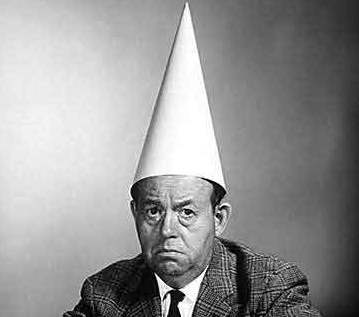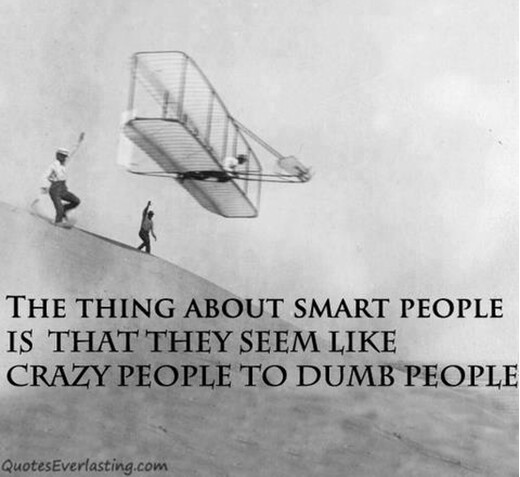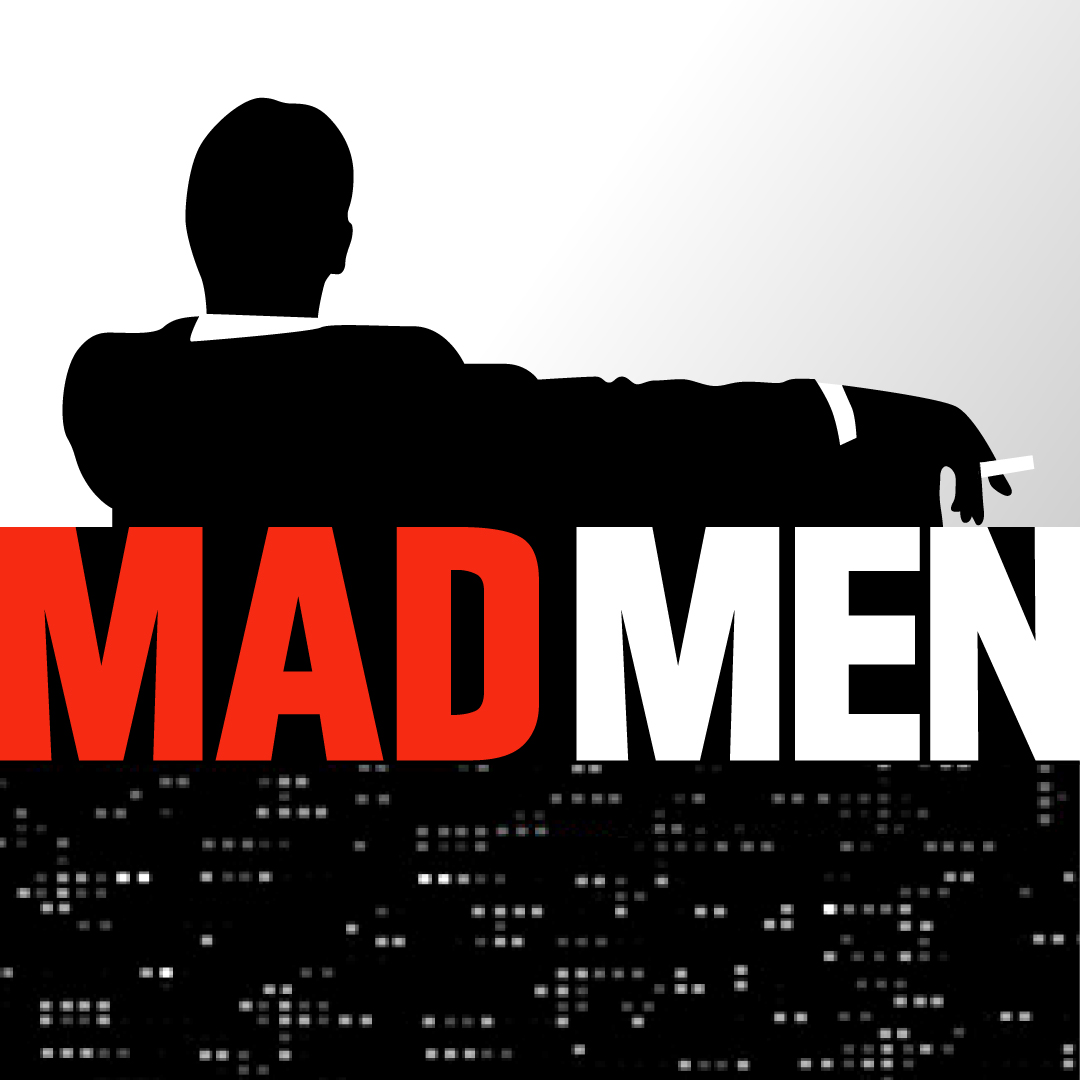Not too long ago, I  watching a series on PBS about the Seven Deadly Sins (Wrath, Pride, Envy, Greed, Sloth, Lust and Gluttony) and things started churning in my mind. So I decided to list my “Seven Deadly Sins of Marketing,” given what I continue to see taking place within marketing and marketing departments across all different industries.
watching a series on PBS about the Seven Deadly Sins (Wrath, Pride, Envy, Greed, Sloth, Lust and Gluttony) and things started churning in my mind. So I decided to list my “Seven Deadly Sins of Marketing,” given what I continue to see taking place within marketing and marketing departments across all different industries.
Guessing
In the Dilbert cartoon series, Dilbert says that “marketing is just liquor and guessing.” Funny…but as we know, a bit simplistic. Yet, too many companies assume that there is absolutely no need to substantiate their beliefs about the marketplace, about what their prospects want, about why their customers are buying, about what people think of their brand, about most anything having to do with those whom they want to purchase their products or services. Generally the thinking is that no one can know the marketplace as well as the company and the market will accept whatever you offer. Guess (pun intended) how that turned out for Kodak, Borders Books, TWA, and certainly some companies in your own industry! Ask yourself, when was the last time that your company committed the time and resources to do some marketing research…qualitative, quantitative, ethnographic, etc. And do it right.
Marketing by Committee (Indecisiveness)
I’m not sure why, but when it comes to marketing, everyone seems to have a say. Partners, staff, associates, spouses, and the janitor all want to give their two-cents. How about an accounting committee to help figure out where the credits and debits are posted? Or an office supply committee to pick out the colors of pens you order? Many executives forget that great marketing is not about what they like. Great marketing is about what works.
Committees, by nature, are full of compromises so solutions are usually watered down versions that will wind up doing little or nothing to accomplish your growth goals. Marketing by committee leads to lots of bad ideas and poorly thought out plans. Instead of bold strokes from the marketing brush, you get a sea of beige. And then it doesn’t work. Who would have thunk it! The solution is to decide on objectives and budget, and then write a marketing plan. Once the plan is approved, ONE person gets appointed within the organization to take on the role as “the decider.” Empower him or her to make all the courageous decisions required to position your company to dominate your category.
Inconsistency
When different aspects of your marketing messages don’t reinforce each other, the inconsistencies alienate prospects and current customers. Inconsistent marketing distorts clear expectations, makes potential customers unsure of the characteristics of your products and creates unhappy customers who don’t get what they expect. These inconsistencies affect businesses by reducing both initial sales to consumers as well as repeat sales from dissatisfied customers. Also, be consistent with your marketing plan. Don’t stop running an ad, for instance, just because the first insertion didn’t ring your phone off the hook. Give your campaign time to work, but you also need to know when a change in direction is a good idea. Remember, people are not paying that much attention to you, but when they do, it helps if the message you’re saying now is similar to the message that they heard the last time.
Complacency
It’s out there right now. Lurking in the shadows of your success. It is the silent business killer that strikes without warning and can bring even the biggest and the brightest companies to their knees. What is this hidden terror? Complacency. We all know it better as the dreaded “status-quo.” It generally takes the form of “whatever we did last year.” Except, things change. Your competitors are changing things up. Your customer’s needs are changing. The marketplace is changing. A few things to avoid complacency: Keep looking in your rearview mirror to see what your competitors are doing. Listen to new ideas as the next big idea may not come out of your own mouth. And, strive to always do better even before you are forced to react to a competitor’s challenge.
Lack of Focus
Okay, so after reading articles by “experts” about how you should have a customer engagement program in place (so you can be more “customer-centric”), you’ve put your company on LinkedIn, YouTube, Facebook, Twitter, Google+, and Pinterest. Heck, you’re even ready to go when the next big social media platform launches. You’ve got your product literature online, and your Web site has a blog and videos. Not to mention all the offline activities ranging from tradeshow activities to advertising to PR, etc. But why did you believe you needed to be in ALL of these social media locations in the first place, and, just as importantly, who is making sure that all of these activities work together?
Narcissism
It’s ridiculous that I have to say this but the memo has not reached the desk of many marketers, so here goes: “It’s not about what your company wants to say but rather about what the customer wants to hear.” (I feel better having said it.) Look, if you want to market based on your personal preferences without regard for what works best with your prospects, that’s your prerogative. But I’d suggest that your company’s marketing not be so self-absorbed. Remember, you don’t buy from you, others buy from you and they don’t care about your business and your troubles nearly as much as you do. Most people are tuned into Radio Station W.I.I.F.M. —“What’s In It For Me!” If your marketing message is all about you, then your customers won’t notice what you’re saying. Please begin to “tune” into your customers, find out what they really want and focus your message on them.
Confusion
Maybe, just maybe, the deadliest marketing sin of all is not having one over-arching marketing strategy – and insuring its implementation through all your tactics. Executing marketing tactics without having a well-developed integrated strategy is like leaving your roadmap tools at home and taking off on the drive without considering if you’ve chosen the right road. You wouldn’t haphazardly set off on an important trip in your car so why let it happen with regard to your company’s marketing activities. It’s easy to start with the “how” but if you haven’t identified the “what,” you may find yourself spending a lot of time executing tactics that don’t take you where you want to go and in so doing, you’ll be wasting time, resources and losing out on sales-producing opportunities. What is needed is one single integrated strategy that looks across all delivery platforms whether online or offline, print, broadcast, or mobile. Your customers don’t have an online self and offline self and neither should you. Think holistically about all your marketing initiatives.
Yes, there are more Deadly Sins that I could have talked about, like trying to be a “do-it-yourselfer,” or not measuring your activities, or saving yourself into bankruptcy, but the above are the Seven Marketing Sins I rank topmost. Now, let us all go out and to the best of our ability, sin no more.
####
Rolf Gutknecht is vice president, director of account services for LA ads. To discuss your thoughts with Rolf on this blog or any marketing matters, email via this link, or visit www.LAadsMarketing.com. You can also connect with Rolf on LinkedIn.
 Over the past year, I’ve been having a conversation with clients, co-workers, friends and family about “the state of marketing” and the results are in. Marketing (and its various forms) seems to be dumbing down more and more. And since I’m not wired to accept mediocrity or any real form of laziness, allow me just this one time to channel my best Peter Finch (in the movie Network) and say “I’m as mad as hell and won’t take it anymore!”
Over the past year, I’ve been having a conversation with clients, co-workers, friends and family about “the state of marketing” and the results are in. Marketing (and its various forms) seems to be dumbing down more and more. And since I’m not wired to accept mediocrity or any real form of laziness, allow me just this one time to channel my best Peter Finch (in the movie Network) and say “I’m as mad as hell and won’t take it anymore!”
Can someone please tell me why this is going on? In what forms does this dumbing down of marketing play itself out? Well, for starters, open up any newspaper, magazine or trade pub. Turn on any TV or radio station. Drive down the street and look at the billboards or bus panels. And even online. It’s all around us… at home, at work… even on vacation. There’s isn’t a day that goes by where I don’t see some sort of advertising or marketing effort and say “what in the world are they trying to say?” This coming from a guy who, as humbly as I can say this, can put 2 and 2 together pretty darn quick. But the mental gymnastics that I have to do to try and get the point, if I can get there at all, is becoming more and more prevalent. In most cases, the message is convoluted. Other times, the message is beyond generic so much so that any company in that industry (and in many cases, in another industry) could say the same thing. Oh and then let’s not forget about puns or borrowing from successful campaigns (“Got Dog Food?” “Got Rice?”) Many times the channel isn’t right for the message and the message is obviously shoe-horned into the event or activity. Whether B2B or B2C environments, it goes on. Please tell me that you’re seeing the same thing. You are, right?
Additionally, I’m gobsmacked (haven’t used that word in a while) at the type of “discussions” on issues that are being pondered within some of the LinkedIn groups of which I’m a member. From the “Is it important that Sales and Marketing be on the same page?” to discussions that people dare not ask of their coworker “How do I go about finding a direct mail printer?” Not to mention the blogs that deal with the details of details. On top of that, there also seems to be this craze for incorporating each new marketing tool, channel or approach (“the next big thing”) as though it will be the silver bullet to all the company’s marketing problems. And, to make matters worse, there’s a sprint to implement each new specialty, and in doing so, marketing starts heading down the slippery slope of actually getting further away from understanding the real world in which prospects and customers make purchasing choices. I think we can agree that this is neither good for the organization or for business as a whole. Not good at all.
OK, at what point in time was it decided that DIY is as good as what a successful outside marketing firm could provide? My business partner coined a phrase that I really like: “DIY is pervasive but hardly persuasive.” Yet it seems to be what we’re seeing in the world today. The seemingly fun and economical do-it-yourself route usually leads to less than optimal results. Just because one understands how to use some design software doesn’t mean the outcome will help in achieving the goals set for that individual piece of marketing material. I think that we might all agree that what separates the best work from the rest of the herd is what one does with the tools and not the tools themselves.
Another way that I see dumbing down happening is but the shear amount of specialization that goes on. This is not to say that being a specialist is a bad thing…it’s not… but as the marketplace continues to evolve and in so doing become more complicated, there are lots of marketers who know more about less and less due to being so specialized. What I mean is that these “specialists” are so focused on what they’re good at, they forget that you can’t solve an equation by concentrating only on parts of it. They can’t see the forest for the trees!
So how did this all come about? Well, as CEOs and CMOs whacked away at their marketing budgets over the last decade, they stopped hiring the most experienced and talented marketing professionals, the guys and gals with real degrees in marketing and gray hair earned on the battlefields of brand-building. Instead, they hired people with “3-5 years experience” or moved over someone from human resources or finance or even the clerical pool to fulfill the marketing. Or they brought in specialists with social media or website experience and made them responsible for the whole marketing affair. Is it any wonder, then, that we’re seeing the kind of marketing on exhibit every day?
With the marketplace getting more complex and customers becoming more sophisticated than ever, now’s not the time to dumb things down but to think and behave like smart marketers once again.
####
Rolf Gutknecht is vice president, director of account services for LA ads. To discuss your thoughts with Rolf on this blog or any marketing matters, email via this link, or visit www.LAadsMarketing.com. You can also connect with Rolf on LinkedIn.
 So you have a horde of demographic data, but do you really understand: Who is your customer? This question is not as easily answered as you think.
So you have a horde of demographic data, but do you really understand: Who is your customer? This question is not as easily answered as you think.
If you’ve written a marketing plan in the past 10 years or so, you’ve probably described your company’s target audience like lots of other marketing people do. And by that I mean things like “adults 55-65 who enjoy eclectic rock music and listen to Pandora” or “men 25-40 who like to run or bicycle 2x per week” or “CFO’s of businesses with annual sales between $15-$25 million.”
While these descriptions all follow the format taught in Marketing 101 to MBA classes in universities around the country, they’re unfortunately all nearly worthless because they provide almost no relevant information for making strategic decisions. Yes, it’s important to have this kind of information be part of the target audience description, but every year, innumerable marketing directors automatically write up plans with these kinds of empty descriptions of their target audiences. And every year, these same companies run around trying to figure out why they’re not really connecting with their customers.
Why demographics aren’t enough
First of all, your customers aren’t demographics. They’re not age ranges…or job titles…or geographical regions…or salary brackets. They’re human beings. It’s almost ridiculous to have to say that, but companies are constantly unable to remember this basic fact. Consequently, these so-call customer-centric organizations continue to roll out downright uninspiring messages to their audiences. “Got (fill-in the blank)?” Or “Do you like to garden? Then you’ll love GroundHog Tiller”? Or, “Kangaroo Jumpers are designed for the active adult outdoor workout enthusiast.” Or, “Springboard provides IT professionals and developers with the platform and tools needed for server administration, application extensibility, and interoperability.” While good money is spent in creating online sites, digital advertising, offline marketing materials and media placements, customers roll their eyes and shake their heads in disbelief (or worse, simply ignore the messages) because they know marketing drivel when they see it–just like you do–and they quickly move on to something more fascinating and relevant.
To sum it up, demographic information is good to have because it’s helpful to know something about the people you’re targeting and it gives you a good foundation to build our buyer personas on. But in today’s world, mere demographics 1) don’t tell you what these people’s pain points are, 2) they don’t tell you about their personal goals, and 3) they don’t tell you about interests and style. That’s why demographics just aren’t enough. Real-life people (i.e. your wife/husband, your mother/father, heck, even you) don’t view themselves as demographics. So as marketers, we shouldn’t view them that way, either.
Getting to know your customer
If it’s important to connect with your customers so that they take the time to listen to what you have to say, you have to stop pushing uninspired marketing clichés on them and instead focus on understanding who they really are, how they really think, and what’s really important to them. That soccer mom driving the crossover SUV with 2.5 kids? Well, her name is Lori. Yes, she goes to early morning workout classes at her fitness club, but do you know why she goes? She’s also on Facebook at least twice per day, but do you know why? Stop making assumptions (because you’ll probably be way off) and start asking questions. Then, when you start to understand, you can get real in the way you talk to Lori. (FYI, Lori goes to early morning workout classes because…she worries about heart disease as she ages since her aunt died of a heart attack at 51, and she’s on Facebook twice per day because…she’s responsible for the social media activities for her company. Probably not what you thought, right?)
Everyone sees the same person
So once you better understand what’s going on in the minds of your audience, you can do a few things to ensure that this information doesn’t just sit in a binder on shelf, but rather that it becomes an everyday part of how your marketing activities are created and put to work.
One example, and a personal favorite of mine, is to create a “customer persona” – an example of the person that would interact with your product or service – with a name, face, and look to help your team connect with your target audience in a more direct and insightful way. In order to achieve this, you need to recognize (or at least imagine) that prospect’s personal and professional interests, priorities, aspirations, fears, motivations, goals, pain points, etc. These factors will have a major influence over what catches their attention when it comes to solving a business issue. Personas concentrate on what a user does, what frustrates the user, and what gives the user satisfaction. A good persona is a narrative that describes a person’s typical day and experiences. In short, bringing the “user” to life helps you better understand what drives your user so you can build around that. (Note: There are numerous customer persona examples that you can source online to show you how it’s done.)
As a result of creating a customer persona, your team no longer has to try and hold an abstract or numeric customer profile in their heads. Nope. All they have to do is ask, “What would Lori think about this?” This simple but important change can bring about significant differences in the way a company considers its customers during decision-making processes.
So, let’s try this again: who is your customer?
####
Rolf Gutknecht is vice president, director of account services for LA ads. To discuss your thoughts with Rolf on this blog or any marketing matters, email via this link, or visit www.LAadsMarketing.com. You can also connect with Rolf on LinkedIn.
 As a partner in a thriving marketing firm that targets companies with $20-$100 million in annual sales, one of my responsibilities is that of business development. While I learn something in each conversation with people in marketing leadership positions, many times after I hang up the phone, I say to myself, “there’s another one who’s losing sales to their competitors!” Mainly that’s because these folks have adopted some misconception about marketing as the “truth” that they can’t and won’t let go of no matter what. So while they say they’d like their sales to be stronger, their year-over-year sales won’t change much or, in some cases, will decrease from one year to the next.
As a partner in a thriving marketing firm that targets companies with $20-$100 million in annual sales, one of my responsibilities is that of business development. While I learn something in each conversation with people in marketing leadership positions, many times after I hang up the phone, I say to myself, “there’s another one who’s losing sales to their competitors!” Mainly that’s because these folks have adopted some misconception about marketing as the “truth” that they can’t and won’t let go of no matter what. So while they say they’d like their sales to be stronger, their year-over-year sales won’t change much or, in some cases, will decrease from one year to the next.
So, let’s do a quick run-through of 5 most common fallacies that I hear. Hopefully none of these sound as familiar to you as they do to me.
I can grow my sales and “share of pie” with a smaller budget than my competitors
When I hear this, it generally implies two things to me: 1) Either your competitors are wasting a big portion of their marketing budget on initiatives or messaging that doesn’t connect with the customers or, 2) your marketing partners are fantastic because they’re willing to work for less than the average market price in order to do the wonderful work they do…which I have a hard time believing is the case. Oh, and then let’s not forget about the inability of these companies to track how much money the competitor is actually (over) spending on marketing.
The reality is this: if your company is spending a good deal less than the competition, you’re probably not making any significant gains in market share. Yes, there might be a competitor that’s overspending, but my experience working with companies from the Fortune 100 to small mom-and-pops is that you don’t pose a serious competitive threat unless your marketing budget is in the same ballpark with your competition….it’s just one of those “marketing truths.”
Marketing’s role is to generate new business
You’ll get no argument from me that one of the jobs of marketing is to generate new business, directly or indirectly. But just as important, marketing’s role is to make existing customers come back for more, that is making customers loyal to the brand. Many businesses are so focused on attracting new customers that they tend to ignore – or even walk away from – the existing ones. Yes, new customers are constantly needed, but truly successful companies prosper on their ability to retain the customers they’ve already acquired. The reason is simple: finding new customers is expensive and time-consuming. Let the following research statistics wash over you….
New business is always good but don’t forget who’s paying the bills.
We’re looking to be more visible with our customers because it leads to better engagement
Reaching the right balance between quality and frequency of the message requires careful consideration. There is a common belief among some that the more we communicate with our customers, the more “engaged” they will become. In fact, not knowing when to “zip it” is a classic marketing mistake that too many marketing people make. If marketing is about building relationships with customers, over-marketing is the best way to kill the relationship and send the customer or prospect heading for the door. A social engagement study entitled “The Social Breakup” prepared by ExactTarget, provides clear evidence of what happens to customer relationships when the marketer comes on too strong:
Guess the biggest reason people break up with companies? (Drum roll)…Too much marketing. The study showed that:
In short, increasing the frequency of communication shouldn’t be your marketing goal. Constantly improving content quality should be.
We don’t need a marketing firm because we can do it in-house for less
It’s the #1 thing I hear the most. A survey conducted by American Express Canada shows that “84% of small business owners say branding is important to overall business success, but only 14% hire third-party experts to help with branding.” I am not surprised by the results, and I can only guess the reasons: agency expense, the desire to have full control over the creative process, poor prior experience with an agency, or possibly the ability to make changes faster on one’s own. So, instead of looking for an outside marketing partner, many companies decide to hire a “marketing person” who wears many hats: graphic designer, social media specialist, copywriter, etc. Let’s be honest, no marketer can be a specialist in everything, unless the company is willing to cut corners on how it presents itself to the world.
Now please understand, I’m not trying to bash the in-house marketing department as there are a lot of smart and talented people out there working for companies. Rather, my point is this: the right outside marketing partner will bring a focus to the marketing initiatives or project, resulting in faster execution time; will come in with an original point of view – more in line with how your customer will interpret the messaging; develop much fresher creative (no “vanilla” wallpaper stuff that gets passed over, and; deliver a much higher level of production quality. Try this on for size: open up 5 trade or consumer magazines and tag or cutout 10 ads that stop you in your tracks… ones that convey a strong value proposition, ones that you wish your firm had done! My completely biased but nevertheless absolutely accurate guess is that all 90% of those ads you clipped out were created by a marketing or advertising agency.
We’re looking for something beyond traditional marketing because that kind of advertising is dead
The internet is chock full of advice on how your company should abandon traditional “old school” communication methods and make the switch to online. It would seem like TV, print ads, billboards, and radio are dying and not worth considering in the overall communication strategy. Yet, research (and lots of it) say this is an incorrect assumption. I think we can agree that the best marketing communication strategy uses a mix of offline and online tactics to reach the target audience. (Do yourself a favor and visit www.marketingcharts.com and subscribe –it’s free. Here you’ll get daily research updates on a wide range of topics including how traditional channels are preferred over digital depending on the audience.)
While it’s true that more money is shifting towards digital, the traditional marketing channels are still heavily required in many business environments. In fact, when Google started getting serious competition, they started running…wait for it…TV ads! When Dollar Shave Club saw that their growth was limited by only online marketing, they started using those old, traditional channels that have in turn made them a rising star company. When there’s a product launch, a sale or just about any other occasion where you need to reach a mass audience quickly and effectively, there’s still no substitute for paid media…and even the dot-coms know it. Think about this, in 2014, the average cost of a 30-second Super Bowl ad was more than $4 million. No CEO or Marketing Director would ever approve such a budget without taking ROI into account, right?
So as I noted earlier, hopefully none of these sound familiar to you. But if on the other hand you’ve heard or said one of these things in the past, know that a lot of confusion, frustration and unrealistic expectations can be eliminated by seeing the world through a different set of lenses.
####
Rolf Gutknecht is vice president, director of account services for LA ads. To discuss your thoughts with Rolf on this blog or any marketing matters, email via this link, or visit www.LAadsMarketing.com. You can also connect with Rolf on LinkedIn.
As we all know, Pinterest and Instagram have become staples on the social media scene. The right visuals (from photos to quotes to inspirational messages) have great appeal and serve as motivation for many. With that in mind, here are some interesting visuals coupled with some content concerning marketing issues that face marketing teams almost daily as they work towards creating the change in the way people use and interact with their company’s products or services. Short, sweet and fun. Click away! 
The average attention span today is roughly 9 seconds…like that of a goldfish. Nine seconds to communicate a message, earn a little bit of loyalty, build a little bit of trust so you can continue the conversation before your customer starts getting distracted! So what could you possibly say in that time or less to get someone’s attention? It starts with presenting your message in clever and unexpected ways. It grabs people’s attention and has them focusing on the message and not thinking about the other stuff that could come into their mind. They’re engaged and captivated. In doing so, it allows you to persuade them, get them to trust you, get them to believe you, get them to want to connect with you. A shift in perspective from speaking about yourself to speaking from the audience’s point of view can be remarkably effective. Witness a beautiful commercial for a British online content company featuring a blind man whose original cardboard sign talks about himself, “I’m blind. Please help.” But when a caring passer-by changes the words to be more audience-focused, something powerful happens. The symbolism is powerful. To read more, click here.
Social media as a pathway to sales is almost certainly not going to work to the degree you want. There…I said it. While social media can be a valuable marketing tool, it’s not magic and it cannot and won’t replace everything that came before it. There’s no quick success and very few programs break through. Coca-Cola says it can find no correlation between “buzz” on Twitter and actual unit sales. Nissan admits it has no idea if social media helps it shift cars. MasterCard can’t tie its social investment to revenues. Don’t take my word for this. Go online and do your own research and see for yourself. In fact, there remains little evidence social media does anything to boost brands’ bottom lines. So then why use social media at all? The reason is that it is an impactful vehicle for empowering advocacy and we know that’s extremely important for brand health and profitability. Social media, if done right, can capitalize on what brand equity your company has already built up. To read more, click here.
 When was the last time you/your marketing team asked the question “I wonder what would happen if we ________.”Crazy ideas have changed the way we go about living our lives. Knowing this, why is it that many marketers still don’t trust the crazy idea when it shows up unexpectedly especially, since crazy ideas, not safe ideas, are the game changers that propel companies forward? In today’s competitive, me-too world, if your product isn’t a legitimate leader in a category, it’s certainly a far better choice to come up with a new value story around your own product or service rather than trying to compete price-wise on the value that was generated by a competitor. You might want to be thinking about a crazy idea that will create a new meaning around your brand. Embrace that mindset so much so that the next time an idea is presented by your marketing department and someone outside of that department says “That’s a crazy idea,” you’ll say, “Thanks, we love it as well!” To read more, click here.
When was the last time you/your marketing team asked the question “I wonder what would happen if we ________.”Crazy ideas have changed the way we go about living our lives. Knowing this, why is it that many marketers still don’t trust the crazy idea when it shows up unexpectedly especially, since crazy ideas, not safe ideas, are the game changers that propel companies forward? In today’s competitive, me-too world, if your product isn’t a legitimate leader in a category, it’s certainly a far better choice to come up with a new value story around your own product or service rather than trying to compete price-wise on the value that was generated by a competitor. You might want to be thinking about a crazy idea that will create a new meaning around your brand. Embrace that mindset so much so that the next time an idea is presented by your marketing department and someone outside of that department says “That’s a crazy idea,” you’ll say, “Thanks, we love it as well!” To read more, click here.
If you want to have passionate customers and dedicated partners, you must first inspire strong responses. But as you attract fans, you’re also bound to get the critics or “Haters.” It’s OK to have some folks (not too many, though) who will not like your brand. The undeniable reality is that if you’re not eliciting a negative response from someone somewhere, then you’re probably not that fascinating to anyone. Think about it, even Apple has Haters as does Starbucks and it hasn’t hurt them. Alternatively, you have the advocates, evangelists, loyalist…the Lovers. They don’t just buy your product or service, they also accept price increases and forgive occasional “issues.” They’re loyal and not just buying your products for price or utility. In the middle are the Lukewarmers. They have a really bad habit of not caring. They won’t buy your product unless it’s the cheapest or most convenient option which means they’re only buying you until a cheaper or more convenient alternative comes around. In today’s marketplace, this middle ground is death!! Not caring is not buying. Not caring is inaction. The world is not changed by people who sort of care or don’t care at all. Stop focusing on the Lukewarmer. Start by having your marketing and advertising be imaginative, original and fresh. To read more, click here.
Having dealt with all sorts of companies and people, I believe the Number One reason for boring “vanilla” marketing messages is the result of trying to please all the people all the time. Fighting the desire to be all things to all people lets you: 1. Stand out from the herd; 2) Attract the like-minded; and 3) Create stronger connections. Vanilla brands might not have enemies, but they also don’t have passionate advocates whose enthusiasm spreads. In order to win the race, you can’t stand still. Vanilla marketing is standing still. To stand out, to be different, to be memorable, takes boldness. It takes being “a real Marketer”. So, however you go about it, stop defaulting to dishing out plain vanilla marketing and start scooping out interesting flavors (think “Cherry Garcia”; “Chubby Hubby”; or “Chunky Monkey”, etc.) that stand out and are uniquely your own. To read more, click here.
So there you have it. 5 visuals that speak to different marketing challenges and opportunities. Maybe these visuals will stick with you for awhile and even change the way that certain projects, campaigns and programs are developed and executed. Seeing is believing.
####
Rolf Gutknecht is vice president, director of account services for LA ads. To discuss your thoughts with Rolf on this blog or any marketing matters, email via this link, or visit www.LAadsMarketing.com. You can also connect with Rolf on LinkedIn.
 While driving in my car the other day, I was thinking about the recent Mazda TV commercials featuring people that invented something that we commonly use in today’s world. Suddenly, I blurted out something that had me stumped by my own question: “Where do all the crazy breakthrough ideas come from?” And when I say “crazy”, I mean crazy as in unexpected… revolutionary…the WOW kind. Well, after doing some quick online research, it turns out that “formless thought (the stuff that just pops into your head) in a creative mind” is where “crazy” ideas originate from.
While driving in my car the other day, I was thinking about the recent Mazda TV commercials featuring people that invented something that we commonly use in today’s world. Suddenly, I blurted out something that had me stumped by my own question: “Where do all the crazy breakthrough ideas come from?” And when I say “crazy”, I mean crazy as in unexpected… revolutionary…the WOW kind. Well, after doing some quick online research, it turns out that “formless thought (the stuff that just pops into your head) in a creative mind” is where “crazy” ideas originate from.
Many of the products that we can’t seem to live without today started out as crazy ideas – ask the Wright Brothers or Henry Ford or Bill Gates or Steve Jobs or the “Mazda Guys” like Bill Simpson – inventor of flame-resistant racing suits or Martin Cooper – inventor of the mobile phone. Or Netflix, Costco and so on. At the time, it was stuff that nobody needed or was asking for (maybe because people didn’t see a problem that needed fixing), but once developed, it was just the thing that people were waiting for. And each idea proved to be a big success in the marketplace. These crazy ideas have changed the way we go about living our lives and it all started as a formless thought. Knowing this, why is it that many marketers still don’t trust the crazy idea when it shows up unexpectedly especially, since crazy ideas, not safe ideas, are the game changers that propel companies forward. On the other hand, safe ideas are the ones you can more easily assume will work before it takes form in the world. (Note: That said, I’ve never quite understood the concept of guaranteeing a new idea will take hold in the marketplace before it actually gets produced, introduced and marketed. With so many factors involved in making that happen, who can do that?)
In some ways, I think crazy ideas are like the ancient fire that early humans feared until proven helpful. Once these humans first learned that fire made life a lot easier – from staying warm to cooking meat – the idea spread like wildfire (pun intended) and was widely accepted as necessary for a more comfortable survival and not something to avoid at all costs. I believe crazy ideas are like that as well.
In today’s competitive, me-too world, if your product isn’t a legitimate leader in a category, it’s certainly a far better choice to come up with new value story around your own product or service rather than trying to compete price-wise on the value that was generated by a competitor, right? So, if you do find your company ranked 3, 4 or lower in your industry, you might want to be thinking about a crazy idea that will create a new meaning around your brand. Think of it like a “Blue Ocean” strategy.
Two examples come to mind…LA Gear (athletic shoe brand-late 80’s) and Swatch (watches).
In both of these cases, as their larger competitors were keeping an eye on consumer needs related to performance features, both LA Gear and Swatch had the crazy idea that people, and lots of them, were more interested in how they expressed their own personality and style, and these people were willing to pay more for products that helped them do it. In the minds of the customer, these products functionally did what competitive products did…but these products also spoke to them on another level. And in doing so, these two “crazy” companies each created a new category and a competitive advantage that they had all to themselves.
OK, so now what? Well, from where I sit, if your brand/product/service is to prosper in a world that’s driven by the daily creation of crazy new ideas, your company will need to choose whether their marketing department, and their activities, will operate from a creative platform or competitive platform.
When your company operates from a competitive platform, it can only win by having somebody else lose, similar in look to that of a “Red Ocean” strategy. Here companies try to outperform their rivals to grab a greater share of product or service demand. As a result, crazy ideas that are formless and unproven will be quickly be dismissed in favor of the known and the “proven.” Typically the marketing messaging and activities for companies operating from a competitive platform are uninspiring, forgettable, and 2nd tier level within their specific industries. They’re totally devoid of connecting with the customer on an emotional, human-to-human level in part because BIG data has played a huge role in the product coming to market. These messages don’t even register a blip on your consciousness radar screen…they’re that uninspiring.
Alternatively, if your organization operates on the creative plane, it will have a compelling reason for being. It will develop products that redefine the category, fascinating customers with the unexpected, making competition and pricing (in most cases) irrelevant. It’s the type of organization where people don’t settle for the status quo and find “crazy ways” to fill in the blank part of the question, “I wonder what would happen if we ________.” In the movie rental business, “What would happen if we didn’t charge late fees?” Thus, Netflix. In retail, “What would happen if we sold quality products in larger/bulk quantities at the lowest possible prices?” Viola: Costco. This creative plane is where so-called crazy marketing ideas are constantly brought to the forefront for consideration. Where non-traditional thinking isn’t immediately shot down because it doesn’t conform to the “we just don’t do it that way” type of thinking. It’s where your competitors say “why didn’t we think of doing or saying it that way?”
Let me ask you a question: What will your company innovate or creatively say in 2014 that will differentiate your business by bringing higher value to your customer base? My vote would be to get crazy, to break away from commonplace. Embrace that mindset so much so that the next time an idea is presented by your marketing department and someone outside of that department says “That’s a crazy idea,” you’ll say, “Thanks, we love it as well.”
####
Rolf Gutknecht is vice president, director of account services for LA ads. To discuss your thoughts with Rolf on this blog or any marketing matters, email via this link, or visit www.LAadsMarketing.com. You can also connect with Rolf on LinkedIn.
 I was having lunch with a friend who is well-respected and recognized in the advertising industry (age of “Mad Men”), when we both started reciting well-known marketing/advertising quotes and how there are as relevant today as they were 40 to 60 years ago. Unfortunately, too many marketing director types immediately dismiss these pearls of marketing wisdom because they think “that was then and this is now.” The problem with that type of thinking is that these people are doomed to make the same mistakes over and over again because they don’t get one important fact: marketing has the same challenges as it did years ago which, in short, is the need to differentiate your message from competitors so people buy your product or do business with you. It’s we just have a lot more channels to contend with today.
I was having lunch with a friend who is well-respected and recognized in the advertising industry (age of “Mad Men”), when we both started reciting well-known marketing/advertising quotes and how there are as relevant today as they were 40 to 60 years ago. Unfortunately, too many marketing director types immediately dismiss these pearls of marketing wisdom because they think “that was then and this is now.” The problem with that type of thinking is that these people are doomed to make the same mistakes over and over again because they don’t get one important fact: marketing has the same challenges as it did years ago which, in short, is the need to differentiate your message from competitors so people buy your product or do business with you. It’s we just have a lot more channels to contend with today.
So, here are five famous marketing/advertising quotes, with a few thoughts on how they relate to your efforts, whether you’re a social media manager, content marketer, or advertiser:
1. “The truth isn’t the truth until people believe you, and they can’t believe you if they don’t know what you’re saying, and they can’t know what you’re saying if they don’t listen to you, and they won’t listen to you if you’re not interesting, and you won’t be interesting until you do and say things imaginatively, originally, freshly.” – Bill Bernbach
My all-time favorite advertising/marketing quote because it really goes to the heart of getting your product or company’s message recognized and acted upon. If you believe what Mr. Bernbach says, and frankly, how can you not, then the whole idea of developing uninspiring, status-quo, “beige” marketing messaging should never be settled for again…ever. Why put forth the effort of creating something that becomes largely invisible to your audience? This quote goes hand in hand with another Bernbach quote: “You can say the right thing about a product and nobody will listen. You’ve got to say it in such a way that people will feel it in their gut. Because if they don’t feel it, nothing will happen.”
2. “When you reach for the stars you might not quite get one, but you won’t come up with a handful of mud either.” – Leo Burnett
I’ve worked both on the agency side as well as the client side and to this date, I’m still shocked at how often the client thinks so little about the growth opportunities for their product or service, while the agency thinks that the product or service is just the “cat’s meow.” Don’t be an “Eeyore-type.” Think big! While there’s also something to be said for having realistic expectations about what you can achieve, there’s nothing wrong with having big dreams and aiming to make them a reality. If you aim a little higher you might just find yourself achieving things that you might not have thought possible.
3. “Why keep a dog and bark yourself?” – David Ogilvy
If you’ve decided that working with a marketing firm is going to help you communicate your value proposition in ways and forms that you otherwise might not have come up with, then believe in the abilities of those you’ve entrusted to do this and step away from playing copywriter or art director. Yes, you’ll know your product much better than the agency in the same way the agency knows how to communicate it to the marketplace much better than you. In short, collaborating is a good thing. Dictating to your marketing partner, well, that’s not how to get the best work done.
4. “I’d rather apologize than to be so timid as to never try and do anything smart or brave.” – Lee Clow
Lee, who created legendary advertising ranging from Apple Computer’s “Think Different” to the Energizer Bunny to Taco Bell’s Chihuahua to California Cooler, knows of which he speaks. The reason these brands became megabrands is because they recognized good work and weren’t afraid, yes, unafraid, to put it out there for the world to embrace. They rejected the status quo. While your company might not ever become a megabrand, it certainly has in it the ability to fascinate your audience more than it does now and in doing so make your competitors say “Why didn’t we think of that!”
5. “On the average, five times as many people read the headline as read the body copy. When you have written your headline, you have spent eighty cents out of your dollar.” – David Ogilvy
The headline or title of your ad, blog post, collateral piece, Twitter post, YouTube video, etc., is the most effective way to get people to give you the 8 seconds of attention that you want before the reader decides to move on to something else. In short, the purpose of your headline is to get people to read your first line. The purpose of your opening line is to get people to read the next one. If you don’t embrace – and more importantly, implement – this principle, you’re going to miss out on a lot of readers. Employ headlines that stop the prospective customer. Don’t let it be anything but scintillating.
“The consumer isn’t a moron; she is your wife.” – David Ogilvy
“Rules are what the artist breaks; the memorable never emerged from a formula.” – Bill Bernbach
“Creativity may well be the last legal unfair competitive advantage we can take to run over the competition.” – Dave Trott
“Stopping advertising to save money is like stopping your watch to save time.” – Henry Ford
“Don’t tell me how good you make it; tell me how good it makes me when I use it.” – Leo Burnett
So take these inspirational quotes to heart and make your advertising and marketing ancestors proud! If you want your brand and products to get more noticed in today’s media-saturated world, you might not have to look any further than the original Mad Men and marketing legends. Their legends for a reason!
####
Rolf Gutknecht is vice president, director of account services for LA ads. To discuss your thoughts with Rolf on this blog or any marketing matters, email via this link, or visit www.LAadsMarketing.com. You can also connect with Rolf on LinkedIn.
 As I write this, my house is in complete disarray. We have a contractor tearing up my girls’ old bedrooms and converting them into a guestroom and an art studio for my wife. It isn’t pretty…but soon will be. As I walk past the tarp and power tools and stepladders, I’m so appreciative that there are people whom I can call on who know how to do this with an assured and desirable outcome. I use experts to prepare my taxes, to check under my engine, to tell me my cholesterol is too high. I leave the do-it-yourself projects to things that have very low consequences if I screw it up.
As I write this, my house is in complete disarray. We have a contractor tearing up my girls’ old bedrooms and converting them into a guestroom and an art studio for my wife. It isn’t pretty…but soon will be. As I walk past the tarp and power tools and stepladders, I’m so appreciative that there are people whom I can call on who know how to do this with an assured and desirable outcome. I use experts to prepare my taxes, to check under my engine, to tell me my cholesterol is too high. I leave the do-it-yourself projects to things that have very low consequences if I screw it up.
Marketing is not a low-consequence endeavor. If it doesn’t succeed, company fortunes and employee livelihoods are at risk. And yet, for too many companies, marketing continues to be a do-it-yourself project.
It doesn’t take an expert to see the results of this by simply flipping through the pages of any newspaper or magazine. Home-made ads are usually the ones you ignore, are plainly designed (or far worse) without style or a fresh point of view. The same goes for websites, Facebook pages, direct mail, radio commercials and company brochures.
D-I-Y is pervasive – but hardly ever persuasive!
We get inquiries all the time from businesses who have been creating their home-made ads and realize that the outcomes haven’t been what they’d wish for. But just as quickly, they pull back, fearful of relinquishing control and suffering sticker shock when they compare the cost of their D-I-Y efforts to professional services. What they’re missing is that by spending money for professional objectivity, expertise and talent, they dramatically increase the chances of their marketing actually having serious bottom-line impact.
The results of making the leap from D-I-Y to seeking out professional help can be dramatic. I’ve seen countless times sizable changes in traffic, sales and inquiries that resulted from putting the marketing in the hands of experts who excel in that craft. That’s how after 20 years, some businesses become overnight successes!
And by “experts,” I’m not talking about letting the shop that designed your banners or flyers design an ad. They’re experts in quick print projects. They’re not a marketing firm or an advertising agency whose portfolio of work comes with recognizable brands; as a result they don’t know how to help you build a long-term competitive position in the marketplace. Nor am I talking about brother Bernie’s kid who took two semesters of computer graphics and makes rock band t-shirt designs.
Every town has ad agencies and marketing firms who can provide you the ideal strategic guidance and talent required to make a difference. As you know, they come in just about every flavor, from one-man shops to multi-floor mega-agencies. Selecting the right company is a matter of chemistry, portfolio, history of success and their desire to win your business. It’s no different than choosing an accountant, contractor or garage mechanic. Price is a factor, but should never be the deciding factor – any more than seeking out the cheapest physician when you’re worried about internal bleeding. (Remember, it’s your company’s life on the line.)
Here are some tips in selecting a marketing provider (or better yet, a marketing partner!):
Just remember, success isn’t about your being able to do everything or know everything. It’s about being able to find the very best resources to complement what you do and know.
That’s why I know when to run to Home Depot myself and when to call on the guys who are ripping out the girls’ closets right about now.
####
Rolf Gutknecht is vice president, director of account services for LA ads. To discuss your thoughts with Rolf on this blog or any marketing matters, email via this link, or visit www.LAadsMarketing.com. You can also connect with Rolf on LinkedIn.
 Oh, the wonder of beautifully crafted taglines. Those few strategically selected words that sum up everything your business stands for and what you want your target audience to know about you. They’ve made companies fortunes by telling people what makes them standout in the sea of sameness. Consider FedEx’s brilliant “When it absolutely, positively has to be there overnight.” Nine simple words that tell FedEx buyers precisely what they’re going to get, while simultaneously informing all of its employees what their mission is. What if FedEx’s slogan was “We ship things!”? Would Nike be as successful if it allowed an executive committee to red-pencil “Just do it” into “When you need great shoes”? How would BMW’s vision change if “The Ultimate Driving Machine” became “Our cars are fun to drive!” My point is that these companies didn’t settle for weak platitudes or vague, generalized statements that could have applied to their competitors. Nope, they decided that they weren’t going to settle. Instead standing out and differentiating themselves was business-critical. Can the same be said for your company and its marketing? Do you have a themeline or slogan that makes you stand out? Is it unique and memorable? Or is it mediocre because somewhere down the line, people settled?
Oh, the wonder of beautifully crafted taglines. Those few strategically selected words that sum up everything your business stands for and what you want your target audience to know about you. They’ve made companies fortunes by telling people what makes them standout in the sea of sameness. Consider FedEx’s brilliant “When it absolutely, positively has to be there overnight.” Nine simple words that tell FedEx buyers precisely what they’re going to get, while simultaneously informing all of its employees what their mission is. What if FedEx’s slogan was “We ship things!”? Would Nike be as successful if it allowed an executive committee to red-pencil “Just do it” into “When you need great shoes”? How would BMW’s vision change if “The Ultimate Driving Machine” became “Our cars are fun to drive!” My point is that these companies didn’t settle for weak platitudes or vague, generalized statements that could have applied to their competitors. Nope, they decided that they weren’t going to settle. Instead standing out and differentiating themselves was business-critical. Can the same be said for your company and its marketing? Do you have a themeline or slogan that makes you stand out? Is it unique and memorable? Or is it mediocre because somewhere down the line, people settled?
Let’s face it, we have a tendency to settle. It’s almost human nature. We settle for something that’s not just quite right, an outfit that isn’t our best look, a job that doesn’t maximize our talents or an ad or website page that’s okay or just “good enough.” While the act of compromise in life, relationships and particularly conflict is an admirable trait, compromise or “settling for” in marketing is a death knell.
You see, the whole point of your marketing activities is to get noticed; get engaged with your audience; and have your work be acted upon to bring in the business. Alternatively, anonymity, swimming in the center of a school of other fish, may be a good survival tactic if you are an anchovy, but it is not a good survival tactic for business. So you have to wonder why so much marketing – and so many marketers – feel the need to play “follow the leader” with respect to marketing trends.
The logic is that if others have done something successfully, you just need to do the same thing. Well, maybe. And then again, maybe not. As we all know, breakthrough products and breakthrough marketing campaigns are not achieved through conformity. Note the word “break” in breakthrough. These are the products and campaigns that break the rules. These are the products and campaigns that use insight, intuition, experience, sensitivity to the marketplace – and arguably the most important thing….courage – to do things differently. To break away from the status quo.
It is certainly true that most companies don’t have that innate insight and courage to be successfully different. We can’t all be like Steve Jobs. But for those are willing to do things differently and well, for those who want their companies to stand out, then the only rule that matters is: You cannot achieve exceptional success through conformity.
To that end, you can have your brand and product/service stand out if you’re willing to take a risk. For starters, ask yourself these three questions:
1. What’s can you say about your company that’s seen as a unique or fresh alternative to your competitors? This can range from the product or service you offer to the way you do business to that of sharing your wisdom. Think beyond the obvious. Dig deeper. Ask yourself a bunch of “So what does that mean?” and “Why would our customer care?” with each answer that’s given.
2. What medium makes the most sense for your brand? The goal is to create a campaign that drives conversation and ultimately revenue. So what imaginative or different ways (to what you’ve been doing) should be explored and implemented. Doing the same thing from one campaign to another, especially given all of the new technological and interesting messaging channels out there, is not only boring but could be seen by management as, well, not a great reflection on yourself.
3. How will you execute your campaign? Don’t risk looking amateurish or wasting time by trying to save money. Engage yourself with people that can help you get to the BIG idea and then help you implement it in a way that you and your executive management team are proud of. You’ll always remember the big successes, while you’ll forget how much money you saved or spent.
Clearly, whether it is investing in advertising, developing a little more creativity, spending the time to follow-up or making the effort to engage with your customers, you can easily elevate your marketing to where it needs to be. Anyways, what progressive marketer wants to settle for second best, or worse, be recognized as mediocre? That doesn’t play well either at the current company or when you need to show your portfolio of work if switching jobs. Instead, risk being brilliant instead.
####
Rolf Gutknecht is vice president, director of account services for LA ads. To discuss your thoughts with Rolf on this blog or any marketing matters, email via this link, or visit www.LAadsMarketing.com. You can also connect with Rolf on LinkedIn.
“Life can only be understood backwards; but it must be lived forwards.” – Soren Kierkegaard
 The last quarter of 2013 is almost history and as we stand poised to welcome 2014 in just 50 days from today, we hope for a future that is successful, rewarding and where dreams will be realized. Having seen the start of more than a few “new business years” during my career, I’ve learned that you can do one of two things in preparation for the coming year. You can yet again try to create a brand new marketing strategy for the coming year or you can pause, look back and do some serious reflecting, resolving to change, or improve some aspect about how you will initiate your future marketing campaigns. For some people, looking back over the past year may be something better left in the rearview mirror; on the other hand, burying your head in the sand can be seen as the primary ingredient in a recipe for another disappointing year…and you know how much the CEO/President/Owner/ Founder loves that kind of thinking and pending poor results. So before one celebrates the dawn of a new year…take time to ask yourself what are you going to do to change? What does success in 2014 look like to you and your executive management team?
The last quarter of 2013 is almost history and as we stand poised to welcome 2014 in just 50 days from today, we hope for a future that is successful, rewarding and where dreams will be realized. Having seen the start of more than a few “new business years” during my career, I’ve learned that you can do one of two things in preparation for the coming year. You can yet again try to create a brand new marketing strategy for the coming year or you can pause, look back and do some serious reflecting, resolving to change, or improve some aspect about how you will initiate your future marketing campaigns. For some people, looking back over the past year may be something better left in the rearview mirror; on the other hand, burying your head in the sand can be seen as the primary ingredient in a recipe for another disappointing year…and you know how much the CEO/President/Owner/ Founder loves that kind of thinking and pending poor results. So before one celebrates the dawn of a new year…take time to ask yourself what are you going to do to change? What does success in 2014 look like to you and your executive management team?
Speaking for myself and our firm, the end of each year is met with a healthy dose of optimism for the coming year. We see 2014 through a lens of hopefulness, that things will indeed get better. Is that just us or will you and your organization also view the coming year with a level of anticipation that you haven’t had for a few years? Hey, it’s been tough for most everyone out there but let’s remember that at least a few organizations — perhaps your own competitors — have fared better than most despite these trying times. So what have they done to plot a course for a more optimistic and profitable path for success in 2014?
Depending on marketplace factors coupled with how well you were able to strategically position and market your company, the past year was either seen as a success or another year of disappointment. Success if you were able to grow your share of the proverbial pie (maybe at the expense of your competitors) or be sufficiently positioned to stay in business to fight the fight for another year. Or disappointment if things didn’t turn out so well because of…(you can fill in the blank). The question that begs to be asked here is, how much of last year’s success or disappointment was because of something you had no control over, such as good luck or bad luck, and how much was because of something you did or didn’t do given how the marketplace presented itself? I’ve found through personal experience this is the time to be totally honest with yourself. As the quote goes: “Being entirely honest with oneself is a good exercise.” – Sigmund Freud
Hey, I’m all for a bit of luck but you probably don’t want to continue betting future success on lucky things happening in the coming year. With this in mind, here are a few questions to ask yourself as thought starters as you begin the process of looking in the rearview mirror to last year and through your windshield to the next:
As marketers, one thing we know for sure is that change will not stop in 2014. The economy will continue to shift on us —hopefully with less drama. But by reflecting back on 2013, taking control of your marketing activities rather than being tossed around by the waves in the marketplace, along with thinking optimistically about what 2014 can hold, 2014 might actually be a year worth celebrating. It will be for us and hopefully will be for you as well.
####
Rolf Gutknecht is vice president, director of account services for LA ads. To discuss your thoughts with Rolf on this blog or any marketing matters, email via this link, or visit www.LAadsMarketing.com. You can also connect with Rolf on LinkedIn.